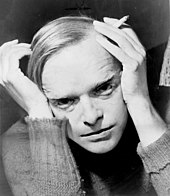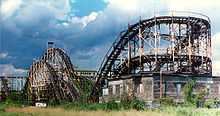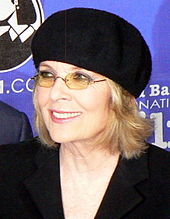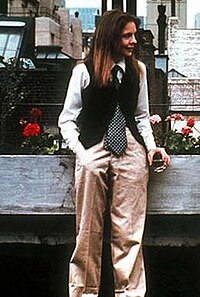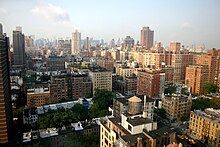Annie Hall
The film stars Allen as Alvy Singer, who tries to figure out the reasons for the failure of his relationship with the eponymous female lead, played by Diane Keaton in a role written specifically for her.
Academics have noted the contrast in the settings of New York City and Los Angeles, the stereotype of gender differences in sexuality, the presentation of Jewish identity, and the elements of psychoanalysis and modernism.
[5] It is also regarded by critics as a landmark "transitional" film in Allen's career, moving his work from more "accessible"[6] and surreal parody towards more "naturalistic" comic filmmaking.
Growing up in Brooklyn, he vexed his mother with impossible questions about the emptiness of existence, and was precocious about his innocent sexual curiosity, suddenly kissing a classmate at six years old and not understanding why she was not keen to reciprocate.
Annie and Alvy, waiting in a movie theater line to see The Sorrow and the Pity, overhear another man deriding the work of Federico Fellini and referencing Marshall McLuhan.
Alvy attempts a return to dating, but the effort is marred by neurosis and an underwhelming sexual encounter that is interrupted when Annie calls in the middle of the night, urging him to come over immediately to kill a spider in her bathroom.
[8] Several actors who later gained a higher profile had small parts in the film: John Glover as Annie's actor boyfriend, Jerry; Jeff Goldblum as a man who "forgot [his] mantra" at Tony Lacey's Christmas party; Beverly D'Angelo as an actress in Rob's TV show; Christopher Walken as Annie's brother, Duane; and Sigourney Weaver, in her film debut, in the closing sequence as Alvy's date at the movie theater.
He selected Gordon Willis as his cinematographer—for Allen "a very important teacher" and a "technical wizard," saying, "I really count Annie Hall as the first step toward maturity in some way in making films.
"[10] He shot in varying styles; "hot golden light for California, grey overcast for Manhattan and a forties Hollywood glossy for ... dream sequences," most of which were cut.
[3] Peter Cowie suggests that "Allen breaks up his extended shots with more orthodox cutting back and forth in conversation pieces so that the forward momentum of the film is sustained.
[15] In one scene, Allen's character, in line to see a movie with Annie, listens to a man behind him deliver misinformed pontifications on the significance of Fellini's and Marshall McLuhan's work.
In one, Alvy stops several passers-by to ask questions about love, and in another, he shrugs off writing a happy ending to his relationship with Annie in his autobiographical first play as forgivable "wish-fulfillment."
[10] He recognized that for the first time he had the courage to abandon the safety of complete broad comedy and had the will to produce a film of deeper meaning which would be a nourishing experience for the audience.
[31] Principal photography began on May 19, 1976, on the South Fork of Long Island with the scene in which Alvy and Annie boil live lobsters; filming continued periodically for the next ten months,[32] and deviated frequently from the screenplay.
There was nothing written about Alvy's childhood home lying under a roller coaster, but when Allen was scouting locations in Brooklyn with Willis and art director Mel Bourne, he "saw this roller-coaster, and ... saw the house under it.
"[35] Rosenblum characterized the first cut, at two hours and twenty minutes,[36] as "the surrealistic and abstract adventures of a neurotic Jewish comedian who was reliving his highly flawed life and in the process satirizing much of our culture... a visual monologue, a more sophisticated and more philosophical version of Take the Money and Run".
The other exceptions include a boy's choir "Christmas Medley" played while the characters drive through Los Angeles, the Molto allegro from Mozart's Jupiter Symphony (heard as Annie and Alvy drive through the countryside), Tommy Dorsey's performance of "Sleepy Lagoon",[42] and the anodyne cover of the Savoy Brown song "A Hard Way to Go" playing at a party in the mansion of Paul Simon's character.
[47] The New York Times' Vincent Canby preferred Annie Hall to Allen's second directorial effort, Take the Money and Run, since the former is more "humane" while the latter is more a "cartoon".
[51] Writing for New York magazine, John Simon called the film "unfunny comedy, poor moviemaking, and embarrassing self-revelation," and wrote that Keaton's performance was "in bad taste to watch and indecency to display," saying that the part should have been played by Robin Mary Paris, the actress who appears briefly in the scene where Alvy Singer has written a two-character play nakedly based on himself and Annie Hall.
In his 2002 lookback, Roger Ebert added it to his Great Movies list and commented with surprise that the film had "an instant familiarity" despite its age,[3] and Slant writer Jaime N. Christley found the one-liners "still gut-busting after 35 years".
[55] In 2017, Claire Dederer wrote, "Annie Hall is the greatest comic film of the twentieth century [...] because it acknowledges the irrepressible nihilism that lurks at the center of all comedy.
The site's critical consensus reads, "Filled with poignant performances and devastating humor, Annie Hall represents a quantum leap for Woody Allen and remains an American classic.
[63] Richard Brody of The New Yorker notes the film's "Eurocentric art-house self-awareness" and Alvy Singer's "psychoanalytic obsession in baring his sexual desires and frustrations, romantic disasters, and neurotic inhibitions".
Vincent Brook notes that "Alvy dines with the WASP-y Hall family and imagines that they must see him as a Hasidic Jew, complete with payot (ear locks) and a large black hat.
[66] Bernd Herzogenrath also considers Allen's joke, "I would like to but we need the eggs", to the doctor at the end when he suggests putting him in a mental institution, to be a paradox of not only the persona of the urban neurotic Jew but also of the film itself.
[73] Peter Cowie argues that the film shows "a romanticized view" of the borough, with the camera "linger[ing] on the Upper East Side [... and where] the fear of crime does not trouble its characters.
[76] Sam B. Girgus considers Annie Hall to be a story about memory and retrospection, which "dramatizes a return via narrative desire to the repressed and the unconscious in a manner similar to psychoanalysis".
His view is that self-reflective cinematic devices intelligently dramatize the difference between surface and substance, with visual emblems "incessantly distilling the distinction between the world mentally constructed and reality".
Costume designer Ruth Morley, working with Keaton, created a look which had an influence on the fashion world during the late-70s, with women adopting the style: layering oversized, mannish blazers over vests, billowy trousers or long skirts, a man's tie, and boots.
[113] James Bernardoni states that the film is "one of the very few romantic comedy-dramas of the New Hollywood era and one that has rightly taken its place among the classics of that revered genre", likening the seriocomic meditation on the couple relationship to George Cukor's Adam's Rib (1949), starring Katharine Hepburn and Spencer Tracy.
